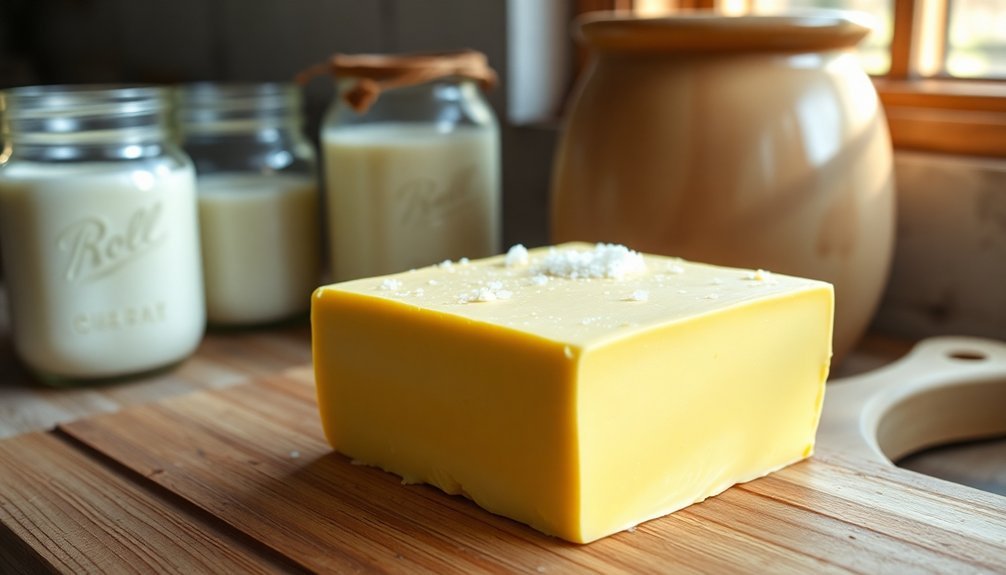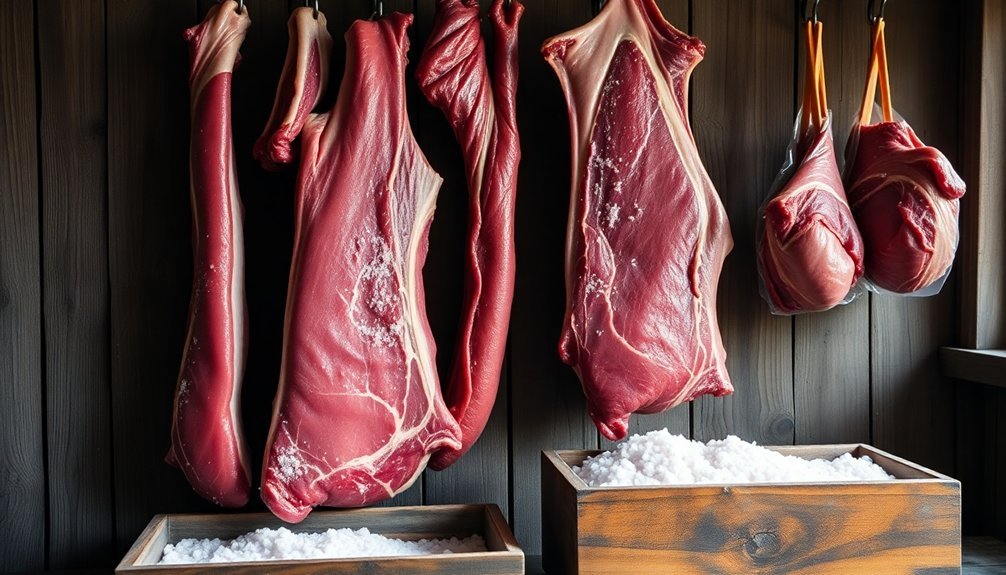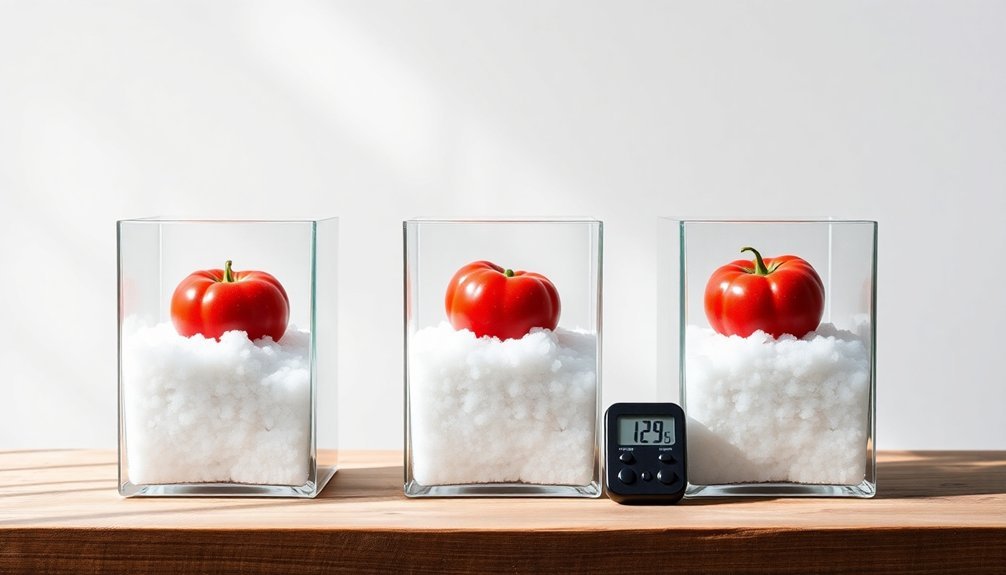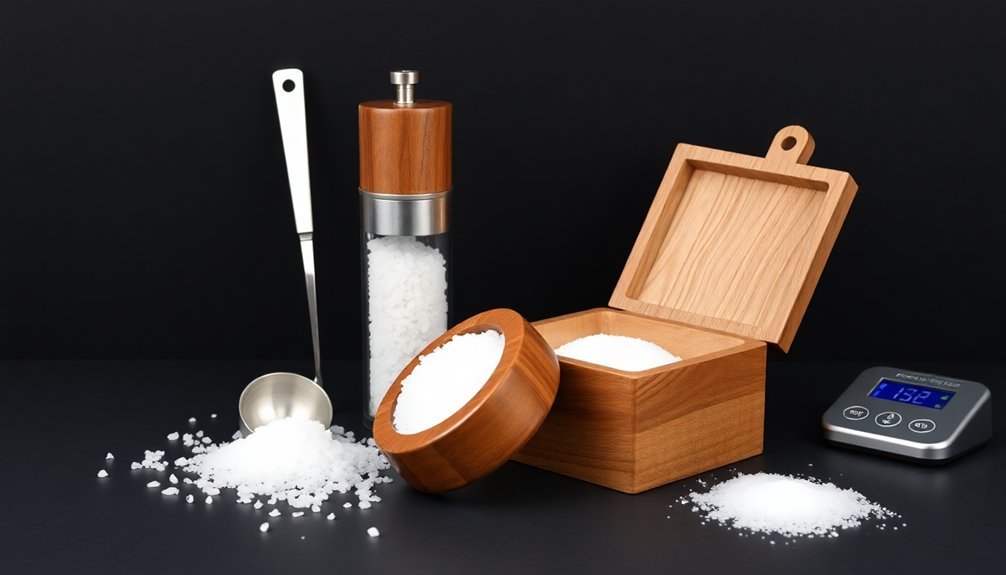Your farm fresh butter can last for months due to its natural composition and proper storage techniques. The high fat content (around 80%) creates a protective barrier against bacterial growth, while beneficial bacteria help inhibit harmful microbes. You'll get the longest shelf life by storing butter at temperatures between -1 to 4°C in your refrigerator, or up to a year in your freezer at -18°C. Wrapping it in aluminum foil or parchment paper protects against light and air exposure. Understanding the significant role of temperature, packaging, and natural preservatives will reveal even more ways to extend your butter's freshness.
From Cream to Farm Butter

Once you've drained the buttermilk, you'll wash the butter grains in clear water and blend them into a smooth paste. The butter must be stored at low temperatures to maintain its fresh qualities for months.
If you're making salted butter, this is when you'll add salt.
The result is a perfectly textured butter that's ready for molding and packaging in protective paper.
Understanding Raw Butter Properties
You'll find that raw butter's high fat content (about 80%) acts as a natural preservative, helping it stay fresh longer when properly stored.
The butter's beneficial bacteria content helps create an environment that naturally inhibits harmful microbial growth.
While the fat molecules create a barrier that limits bacterial growth by separating water molecules, you still need to monitor your raw butter for signs of spoilage over time.
Your raw butter's shelf life depends heavily on storage conditions, with refrigeration greatly slowing down both oxidation and microbial activity that can lead to spoilage.
Natural Fat Content Benefits
The natural fat content in raw butter delivers remarkable benefits for overall health and wellness. You'll find that raw butter's unique composition provides essential lubrication for your central nervous system and joints while restoring moisture to your thyroid. The raw unsalted butter can effectively prevent constipation issues through its natural properties.
Its hydrating properties can help resolve constipation issues and soothe cellular structures throughout your body. Your body's ability to absorb nutrients considerably improves with raw butter's fat-soluble vitamins. These crucial compounds support your brain function, bone health, and hormone balance.
The healthy cholesterol, fatty acids, and antioxidants work together to enhance your body's natural processes.
- Raw butter strengthens your immune system through beneficial bacteria and active enzymes
- It provides essential Lauric acid and immune-boosting vitamins
- The saturated fats support ideal health without proven harmful effects
- Its natural compounds aid in digestion and nutrient absorption
When you consume raw butter, you're not just adding flavor to your diet – you're supporting your body's fundamental functions.
The fats in raw butter are easily processed by your liver, making it an efficient source of energy and crucial nutrients that contribute to your overall wellbeing.
Microbial Activity Over Time
Throughout the aging process, raw butter undergoes significant microbial changes that affect both its flavor profile and safety considerations. You'll notice that raw butter doesn't typically spoil but instead develops a natural souring process, creating deeper, more complex flavors similar to Parmigiano Reggiano. This evolution is due to the active cultures and beneficial bacteria present in the butter.
While these changes can enhance flavor, you'll need to be aware of potential risks. Raw butter can harbor harmful bacteria like Salmonella and E. coli, making proper storage vital. You can maximize safety by keeping your butter in airtight containers and maintaining consistent refrigeration, which slows bacterial growth and extends shelf life to about 60 days.
If you're looking for longer storage, freezing's your best option, as it can preserve raw butter for several months without significant quality loss. You'll find that salted varieties last longer than unsalted due to salt's natural preservative properties.
While raw butter retains beneficial enzymes and bacteria that pasteurized versions lack, you'll need to balance these benefits against the higher risk of contamination, making proper storage techniques fundamental for safe consumption.
Proper Storage Temperature Matters

You'll find that storing your butter at consistently cold temperatures is essential since bacterial growth notably slows down in chilled environments.
When you maintain steady temperatures, you're actively preventing the degradation that occurs with repeated warming and cooling cycles.
Your butter's quality will stay intact longer if you avoid taking it in and out of cold storage unnecessarily, as temperature fluctuations can lead to faster spoilage.
Cold Slows Bacterial Growth
Because temperature plays a vital role in preserving butter's freshness, understanding how cold affects bacterial growth is essential for proper storage.
When you refrigerate or freeze butter, you're actually inhibiting microorganisms' ability to grow and multiply. Cold temperatures reduce bacterial metabolism and make it harder for them to function effectively.
At refrigeration temperatures (4°C), you'll notice these key effects on bacterial growth:
- Bacterial cell membranes become less efficient at processing nutrients
- Metabolic rates slow considerably, reducing spoilage
- Microorganisms struggle to reproduce and multiply
- Enzyme activity that causes food deterioration decreases
Your butter's shelf life extends even further when you freeze it at -20°C or below. At these temperatures, the moisture in butter turns to ice, preventing bacteria from accessing the water they need to grow.
While freezing won't kill all bacteria, it effectively stops their growth and preserves your butter's quality. Remember that salted butter offers additional protection against bacterial growth, even at room temperature, though you'll still want to refrigerate it for best freshness.
For long-term storage, freezing remains your best option as it completely halts both microbial and enzymatic activities.
Steady Temperature Prevents Spoilage
Building on the principles of cold storage, maintaining a steady temperature is just as important as the temperature itself. You'll want to keep your refrigerator at a consistent 37°F to maximize your butter's shelf life. This ideal temperature guarantees your butter stays fresh for about a month while slowing down the oxidation process that leads to rancidity.
If you're planning to store butter for longer periods, your freezer's your best friend. You can extend butter's shelf life up to 18 months through freezing, and you won't compromise its taste or texture. Once you've thawed it, you've got about 30 days to use it under proper refrigeration.
You'll need to take into account your butter's composition when deciding on storage methods. If you're using salted butter, you've got more flexibility due to salt's natural preservative properties. Higher-fat butters (85-90% butterfat) may also last longer.
However, if you're working with unsalted, whipped, or raw butter, you'll need to be stricter about maintaining that steady refrigeration temperature. Remember, while butter's high fat content naturally resists bacterial growth, consistent temperature control remains essential for maximizing its shelf life.
Avoid Temperature Fluctuations Daily
Temperature fluctuations pose a significant threat to butter's quality and longevity. When you're storing farm fresh butter, maintaining consistent temperatures isn't just a suggestion – it's essential for preserving its texture, flavor, and overall quality.
You'll want to keep your butter at steady temperatures to prevent the development of off-flavors and protect its oxidative stability.
For ideal storage, you should follow these temperature guidelines:
- Store frozen butter at -18°C for 8-12 months of maximum shelf life
- Keep refrigerated butter between -1 to 4°C for 1-2 months of freshness
- Never let temperatures rise above 8°C to prevent product distortion
- Maintain frozen storage at -10°C for convenient 8-month preservation
You'll need to be particularly vigilant during summer months or in warm climates, as temperatures above 20°C can cause butter to melt and lose its desirable properties.
Don't forget that proper packaging plays an essential role – using airtight containers and keeping butter away from direct sunlight helps maintain consistent temperatures.
If you're storing large quantities, shrink-wrapped pallet loads offer better protection against temperature fluctuations and condensation-related issues.
Essential Packaging Materials
Proper packaging safeguards your farm fresh butter's quality and extends its shelf life. You'll find several effective packaging options, each with distinct advantages for storing your butter.
Wrapped blocks or rolls using aluminum foil or parchment laminate offer reliable protection against light, air, and contaminants. While they're cost-effective and easy to handle, they don't provide the longest shelf life among packaging options.
Plastic tubs with resealable lids prove convenient for daily household use but may not protect your butter as effectively as other materials.
For long-term storage, especially if you're planning to export or store butter for extended periods, tin cans provide superior protection. Though they're more expensive and less practical for everyday use, they excel at maintaining freshness over time.
When choosing retail packaging, you'll want materials that effectively block light and air to prevent oxidation and rancidity. Your best options include aluminum foil, which offers excellent protection, or composite materials combining aluminum foil with oil-proof paper.
While parchment laminate presents a more eco-friendly alternative, it doesn't provide the same level of protection as aluminum-based packaging.
Natural Preservatives in Butter

- Antioxidants like vitamin E and rosemary extract combat rancidity.
- Tea tree oil provides antimicrobial protection.
- Aloe vera combined with other preservatives enhances stability.
- Grapefruit seed extract helps inhibit bacterial growth.
You can also boost your butter's longevity by combining it with preservation-friendly ingredients like waxes and cetearyl alcohol.
While these natural preservatives work well together, remember that salt remains the most effective and widely used preservative in butter production, especially for everyday cooking and spreading purposes.
Traditional Butter Storage Methods
Throughout history, farmers and home cooks have relied on proven methods to keep their butter fresh and spreadable. Ancient civilizations developed ingenious solutions, from wrapping butter in animal skins to storing it in glazed ceramic containers that prevented bacterial growth while allowing moisture to evaporate naturally.
You'll find that covered butter dishes remain one of the most effective traditional storage methods for room-temperature butter. When you're keeping butter at room temperature, you'll want to store it in a cool, dark place and only leave out what you'll use within a week.
If you're in a warmer climate, you can use the time-tested method of wrapping butter in loose cloth and submerging it in salt water.
For longer storage, you'll get the best results by keeping butter in its original packaging in your refrigerator's butter compartment, where it'll last one to three months at 35-40°F.
When you need to store butter even longer, wrap the original carton in aluminum foil or place it in an airtight freezer bag. You can freeze butter for up to a year, and it'll thaw quickly when needed.
Signs of Quality Butter

Identifying quality butter relies on four key characteristics: color, aroma, texture, and flavor. When evaluating butter quality, you'll want to look for uniformity in color, ranging from creamy white to rich gold. The color variations often depend on the cow's breed and seasonal diet changes, but they shouldn't affect the butter's quality.
You'll know you've found quality butter when it exhibits these essential traits:
- A fresh, milky scent with subtle diacetyl notes – strong buttery aromas often indicate cultured butter, while off-putting odors suggest poor storage.
- Even, easy-to-slice texture that's waxy and cohesive, not greasy or slippery – higher butterfat content typically means better spreadability.
- Clean, sweet, creamy flavor that dissolves slowly in your mouth, allowing you to experience all flavor compounds.
- Consistent color throughout the butter, with no signs of dehydration or oxidation between surface and interior.
European-style butters often demonstrate superior quality due to their higher butterfat content, which contributes to improved texture and mouthfeel.
If you notice a gummy or sticky texture while tasting, or if salt overpowers other flavors, you're likely dealing with lower quality butter.
Best Preservation Practices
For ideal butter preservation, proper washing, salting, and storage techniques are essential. Start by thoroughly washing your butter with cold water, kneading gently until the water runs clear. This removes all buttermilk, which can cause spoilage. Dry the butter completely using a cheesecloth or towel, as any remaining moisture will reduce shelf life.
Add 1 teaspoon of fine sea salt per pound of butter – it's your primary preservative. You'll extend storage time considerably, especially at room temperature, where salted butter can last a month or longer.
| Storage Method | Duration | Temperature |
|---|---|---|
| Airtight Container | 1-2 months | Cool, dark place |
| Brine Solution | 2-3 months | Below 65°F |
| Water Bath Canning | 6-12 months | Room temp |
| Pressure Canning | 1+ year | Room temp |
For long-term storage, you've got several options. Store your butter in airtight containers in a cool, dark place, or preserve it under cold brine in a stone earthen jar. For extended preservation, try pressure canning or water bath methods – heat your jars at 250°F for at least 20 minutes, leaving 1-inch headspace when sealing.
Frequently Asked Questions
Can I Use Frozen Farm Butter Directly for Baking?
You can't use frozen butter directly in most baking recipes. You'll need to thaw it in the fridge overnight, though you can grate frozen butter into pastry doughs for flaky results.
Why Does Homemade Butter Sometimes Develop a Metallic Taste?
Your homemade butter's metallic taste likely comes from oxidation reactions or metal contamination from equipment. You'll also notice this if you're using improperly sanitized tools or cream that wasn't properly cooled.
Does Churning Speed Affect Farm Butter's Shelf Life?
No, churning speed doesn't affect your butter's shelf life. You'll find that cream quality, storage methods, and churning temperature are what really determine how long your farm butter stays fresh.
Can Farm Butter Be Safely Preserved Using Honey?
You can't safely preserve farm butter using honey. It won't prevent rancidity or protect against bacterial growth. Stick to proven methods like salt, brine solutions, or heat treatment for effective butter preservation.
Why Does Farm Butter Color Vary Between Seasons?
You'll notice farm butter's color changes because cows eat different foods across seasons. When they graze on fresh spring grass, they consume more carotenoids, making your butter yellower than winter's paler version.
In Summary
You'll find that farm fresh butter's longevity comes down to proper handling from start to finish. By maintaining the right temperature, using appropriate packaging, and following traditional preservation methods, you can keep your butter fresh for months. Remember to check for quality signs and trust your senses. When you store butter correctly and understand its natural properties, you're ensuring the best possible shelf life.





Leave a Reply